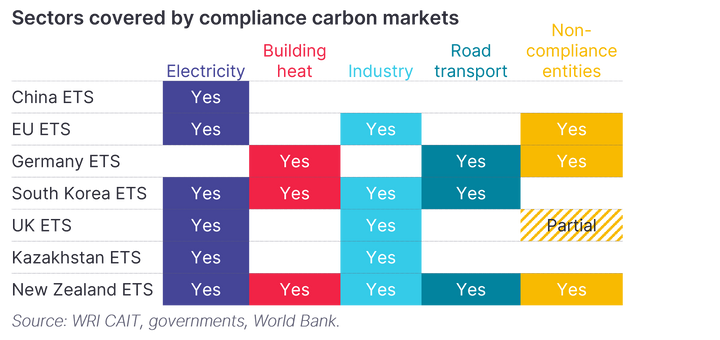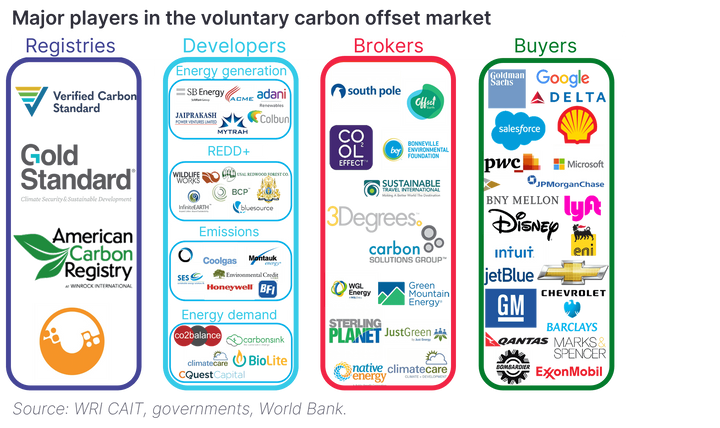The number and variety of players involved in carbon trading is growing, as more governments introduce a carbon-pricing policy and companies seek to use offsets as part of their sustainability strategy.
Key message
Carbon trading incorporates a broad variety of participants from utilities and airlines to registries and commodity traders. Compliance carbon markets typically involve governments, companies required to participate, and the finance and trading community. Voluntary carbon markets have a more complex value chain that involves low-carbon project developers, registries, brokers and corporations looking to meet their sustainability targets.
#Compliance markets
There are three main groups of organizations involved in mandatory, or compliance, carbon programs: policy makers, compliance entities and non-compliance entities.
Policy makers
Governments and regulators design, implement, oversee and enforce compliance carbon markets. They are responsible for deciding how the program will function such as greenhouse gases and sectors to be included, how permits will be allocated, measures to prevent fraud, mitigate carbon leakage or stabilize prices, and rules on trading carbon units. Once a program is launched, policy makers are also responsible for deciding if and how it should be amended.
Governments also play a key role in driving demand and supply in a compliance carbon market: they set the emissions cap or baseline based on their climate targets, and they distribute the permits to the market whether for free or via auctions. They are also central to the oversight and enforcement system – a key component of a robust emission-trading scheme. At the end of each compliance period, regulators ensure that participants’ emission reports are submitted and verified by an in-house team or third party. They also carry out penalties for non-compliance, such as naming and shaming, and fines.
Compliance entities
These companies and organizations are mandated to participate in a carbon market and tend to be individual companies (as in the South Korea and China markets), or individual plants or facilities (as in the EU Emissions Trading System). Under a cap-and-trade scheme, regulated participants must surrender sufficient permits at the end of the compliance cycle to cover their greenhouse-gas emissions. They may acquire additional allowances from the government, other compliance entities and non-compliance entities (see below). They may also be allowed to use offsets.
In addition, participants must follow the procedure for monitoring, reporting and verifying (MRV) greenhouse-gas emissions set by government. This may involve devising a monitoring plan and submitting an emission report that must be verified by an independent organization.
Non-compliance entities
Several compliance markets such as the EU ETS, and the Regional Greenhouse Gas Initiative and the California Cap-and-Trade Program in the US allow the finance and trading community to play a role in carbon trading, for example by buying allowances on behalf of compliance entities or trading allowance derivatives on a secondary market. These entities can include retail speculators, commodity traders, brokers and financial intermediaries such as commercial banks. Exchanges like the European Energy Exchange (EEX) provide a platform for emission units to be traded and in some case offer clearing and auctioning services.
High prices and volatility led to a rise in their participation in compliance carbon markets in recent years, and total assets invested in exchange-traded carbon products rose to a record high in 2022. Such speculators can provide liquidity as well as volatility to carbon markets, depending on their trading strategies. Short-term traders can cause price spikes in a low-volume market where a small number of trades can make up a large proportion of total traded volumes. However, investors with longer time horizons, such as pension funds, could also bring price stability if they take a longer-term view and invest based on supply and demand factors.

#Voluntary markets
A wide range of companies are active in each segment of the voluntary carbon offset value chain.
Project developers
Offsets are created by projects that remove or avoid the release of greenhouse gases into the atmosphere. In most cases, developers undertake projects specifically intended to generate offsets. However, several of the largest developers such as National Hydroelectric Power Corporation, an Indian power generation company, do not specialize in offset projects, but rather use these certificates as an additional revenue stream to fund modifications to their existing assets and business portfolios. In some cases, developers work directly with a corporation to sell offsets through an over-the-counter transaction. But they often interact with brokers.
Registries
These organizations are a crucial component of the value chain as they regulate the voluntary carbon markets, together with various non-governmental organizations. In particular, they serve as a way to track and validate the quality of each offset produced by hundreds of developers. Four registries oversee nearly all of the activity in the market: the Verified Carbon Standard (VCS), Climate Action Reserve (CAR), Gold Standard (GS), and American Carbon Registry (ACR).

Brokers
Once a project is verified, developers often work with brokers, which procure carbon offsets and transfer them to a buyer, or retire them on a buyer’s behalf. Brokers also offer advisory services – an integral part of the offset purchasing process – whereby buyers specify criteria such as the sectors and regions from which they want to buy offsets and the volume of offsets they want to purchase, and brokers will offer a list of options and prices. This simplifies the process of purchasing offsets, though it can extend the timeline compared with purchasing them through an exchange. Many brokers also have direct stakes in projects, which can make pricing transparency and contract terms less straightforward than going through an exchange.
Carbon offset buyers
These consist of companies looking to purchase offsets as a way to compensate for their greenhouse-gas emissions and meet their voluntary sustainability commitments. This may be an interim solution until low-carbon technologies and processes are developed for hard-to-decarbonize activities, or as they approach their climate target deadlines and have exhausted other mitigation options. Despite questions around the legitimacy of using carbon offsets as part of a sustainability strategy, these buyers include many of the world’s largest corporations.
Stay up to date
Sign up to be alerted when the web platform goes live.